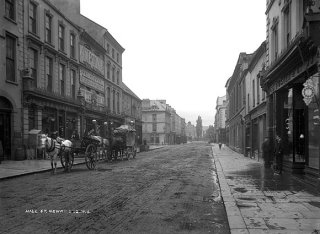Those who choose to trivialise our local history do a great disservice to present and future generations.
Put at its most simple, the truth will be buried beneath their self-serving floss!
John Daly’s Short History of Newry – in addition to the afore stated trivialisations – the Newry Highwayman, ‘first commercial canal in the British Isles’, Act of Union signed at Derramore House etc. – recounted for the umpteenth time the story of the Horse’s Tail.
Each time I hear the story related, a multitude of thoughts beset me: I wonder how Mrs Gordon earned the release of her innocent husband; I speculate on what the horse’s name might have been; I consider what might lie behind the tale of
But most of all, I wonder at the motives of those who would trivialise an epoch-making political revolution-in-the-making by highlighting such a minor, peripheral event.
The real question is this: which people, and at what level, were involved as spies within and without the United Irishmen of Newry to betray and send to a barbarous death, their former comrades? How many were betrayed by Samuel Turner? How many by Isaac Corry? By others? How many innocent town’s merchants and tradesmen were fingered by informers merely for their own commercial or other gain?
Ask yourself: of all the times you heard the story of Mrs Gordon’s hard ride from Templegowan, near Newry to
Never? And why not?
Those who propagate this feeble legend would baulk at the romanticising of political intrigue and revolution as epitomised in such ballads as ‘Who Fears to Speak of ’98?’
Stop again and ask yourself which of the two, better represents the reality of those troubled times.
Anyway, the story first!
Newry was a bustling, thriving and populous town in the last decade of the eighteenth century. In 1792 Theobald Wolfe Tone arrived in Newry with John Keogh, determined to unite different nationalist factions and secret societies behind the ideals of the French Revolutionaries. Partly due to his influence, and that of other leaders such as Dr William Drennan who practised here for a time, Newry became a republican stronghold. Many eminent merchants of the town were said to be republican. The felling of ash trees to fashion pikes became a common occurrence. The yeomanry was openly insulted in the streets and attempts to arrest United Irishmen often led to resistance from townspeople.
Isaac Corry, once the darling of the town, was suspected of responsibility for the arrests. The government took a hard line with the Newry rebels, who were easily identified by spies in their midst. Chief among these, though it emerged much, much later, was Samuel Turner of The Glen.
Suspects were quickly rounded up and sent for summary trial to
On hearing of her husband’s arrest, Mrs Gordon mounted her trusty steed at her home in Templegowan near Newry and rode like the wind to save him from the scaffold. He was saved but the horse collapsed from the effort. His tail was cut off and saved as a memento, though no one thought to preserve the horse’s name for posterity.
You can still see the horse’s tail hanging in pride of place in the Town Hall Boardroom.
I’d have photographed it and uploaded it here to illustrate this story, had I not thought this would merely add to the fairy tale!!
Anyway, it’s there the story always ends.
Are you curious to know the fate of the others? Indeed of the rising in Newry?
What’s wrong with you? Have you not an ounce of romance in your soul?
Who cares that of Gordon’s comrades only he and Glenny escaped?
That among those condemned on the informer’s word were: Robert Leacy, William Reilly, James Jones, Robert Brown and Robert Maxwell of Newry and Sheepbridge: Hugh McEvoy, Edward Fagan, Matthew Savage, Laurence McEvoy and Stephen Byrne.
Who cares that the betrayals continued right up to the Rising itself – many on the word of informers who had fled the town and the wrath of its inhabitants to sanctuary abroad?
The story of Cochran and Lowans is told elsewhere on these pages.
And of the traitor, Isaac Corry.
But everybody likes a fairy-tale romantic story, don’t they? ………………
Well, perhaps ….
if it’s told as such – and not confused with the tragic history of our town!
